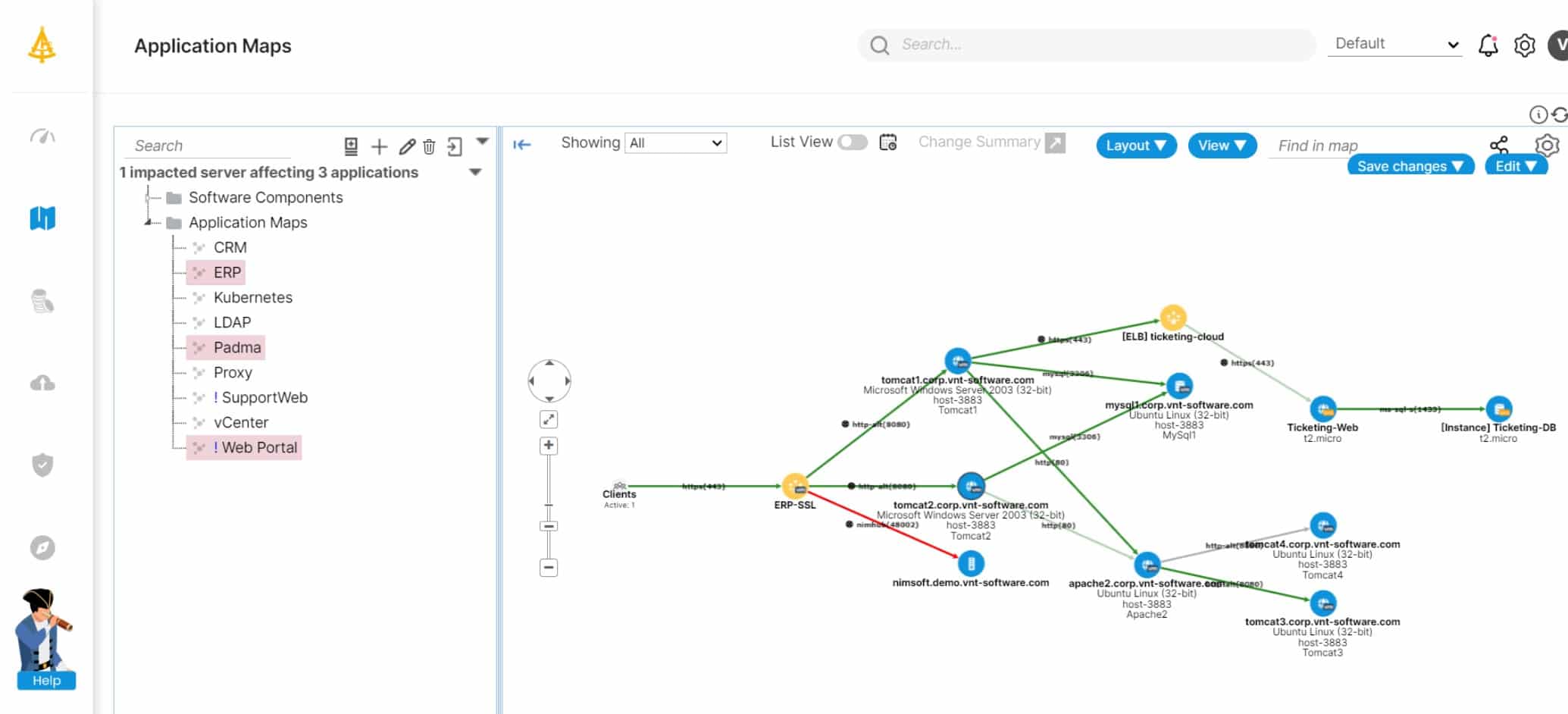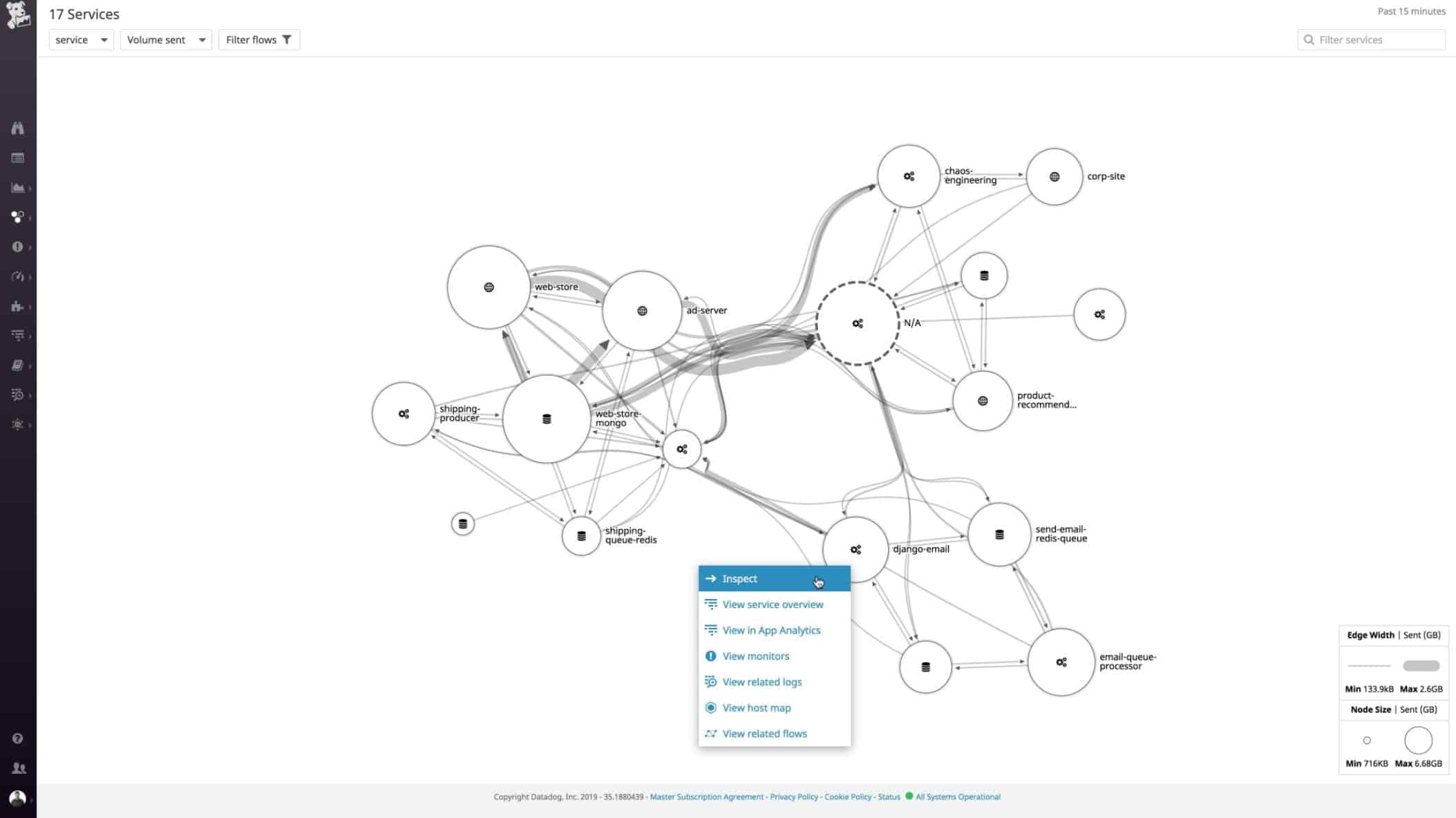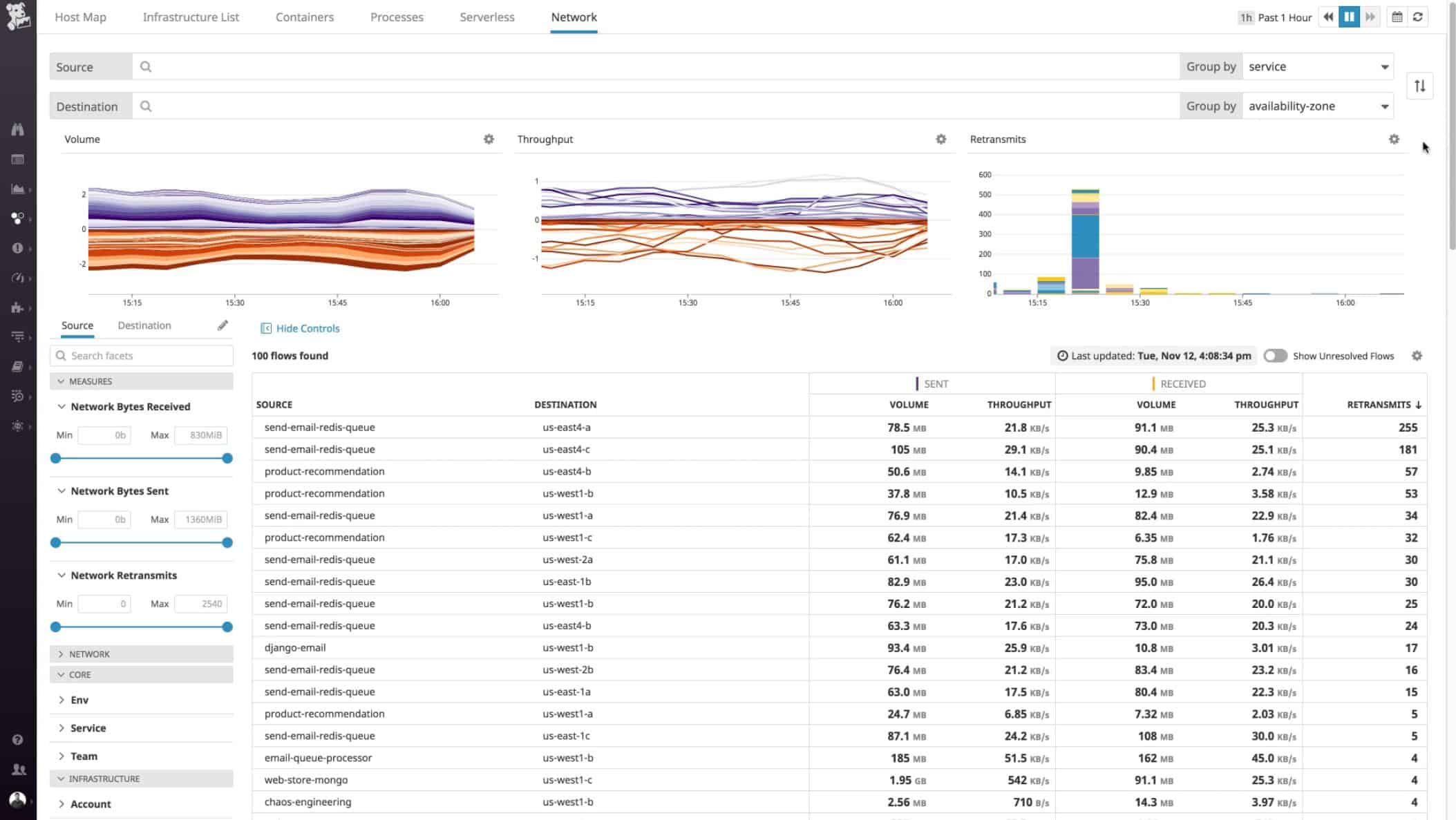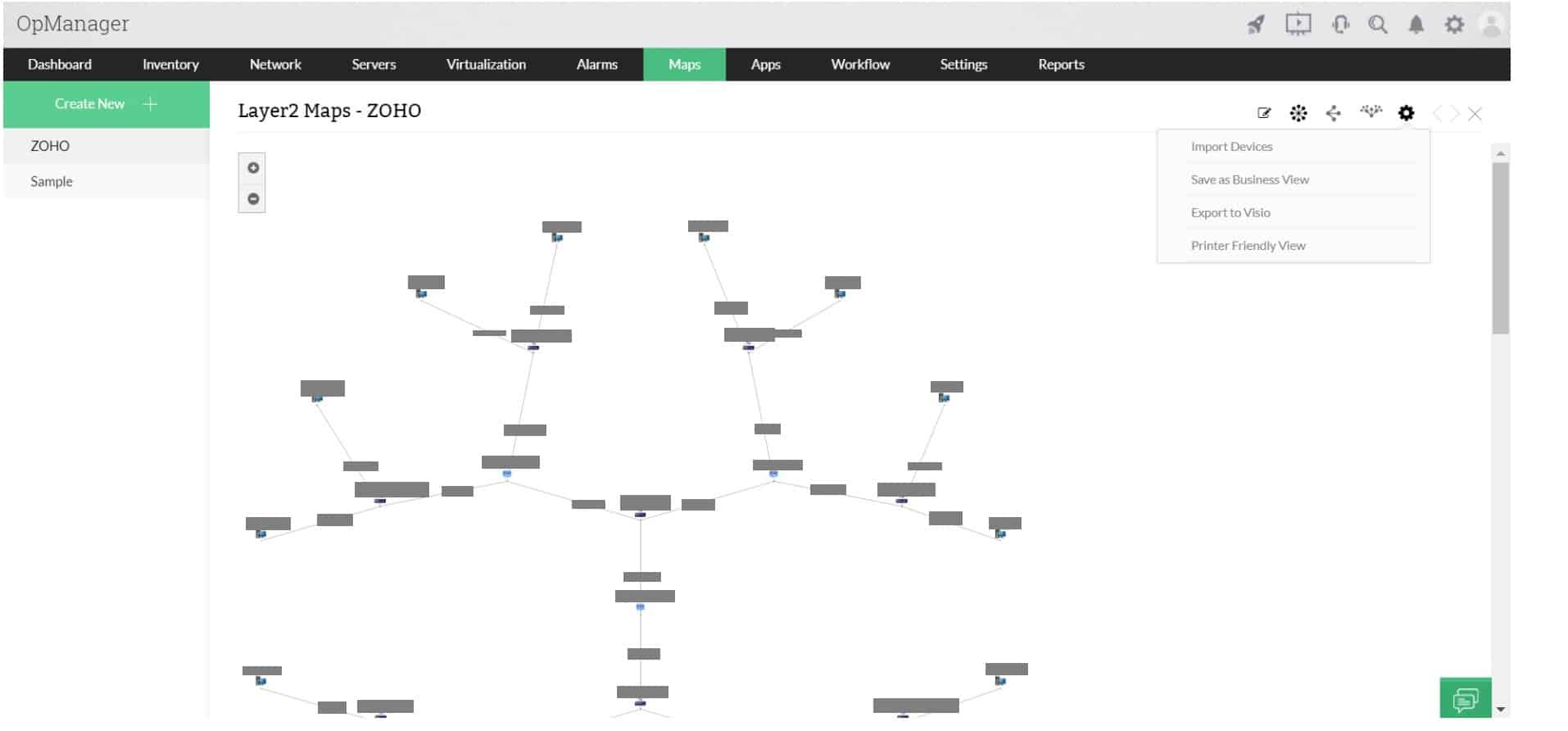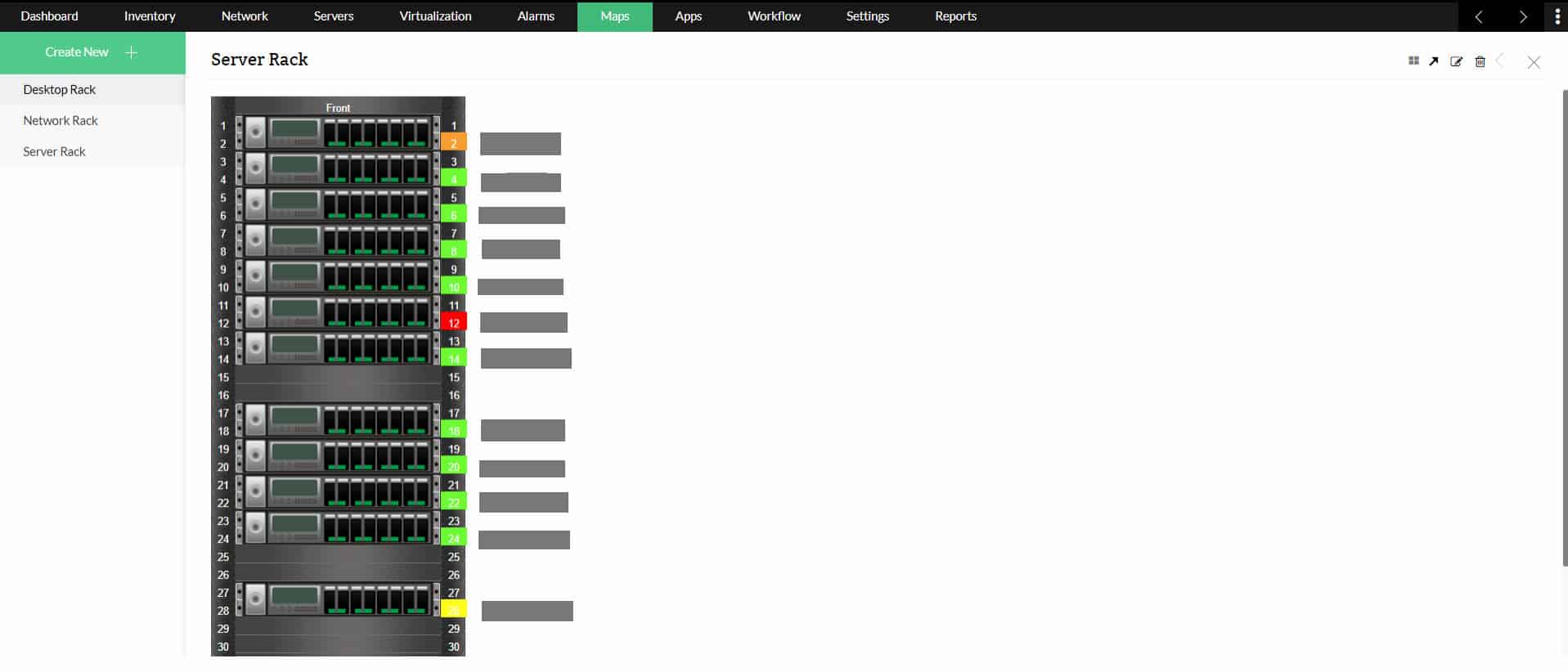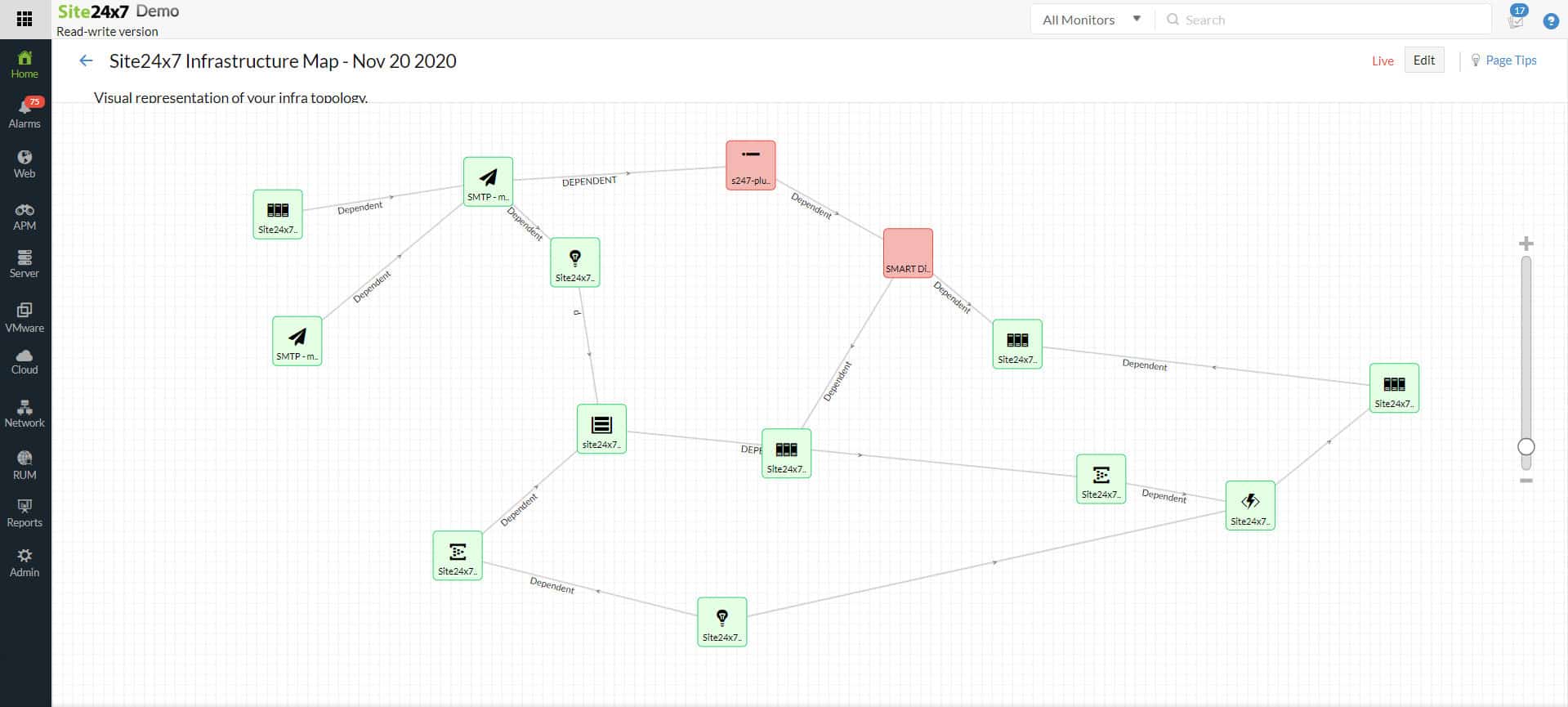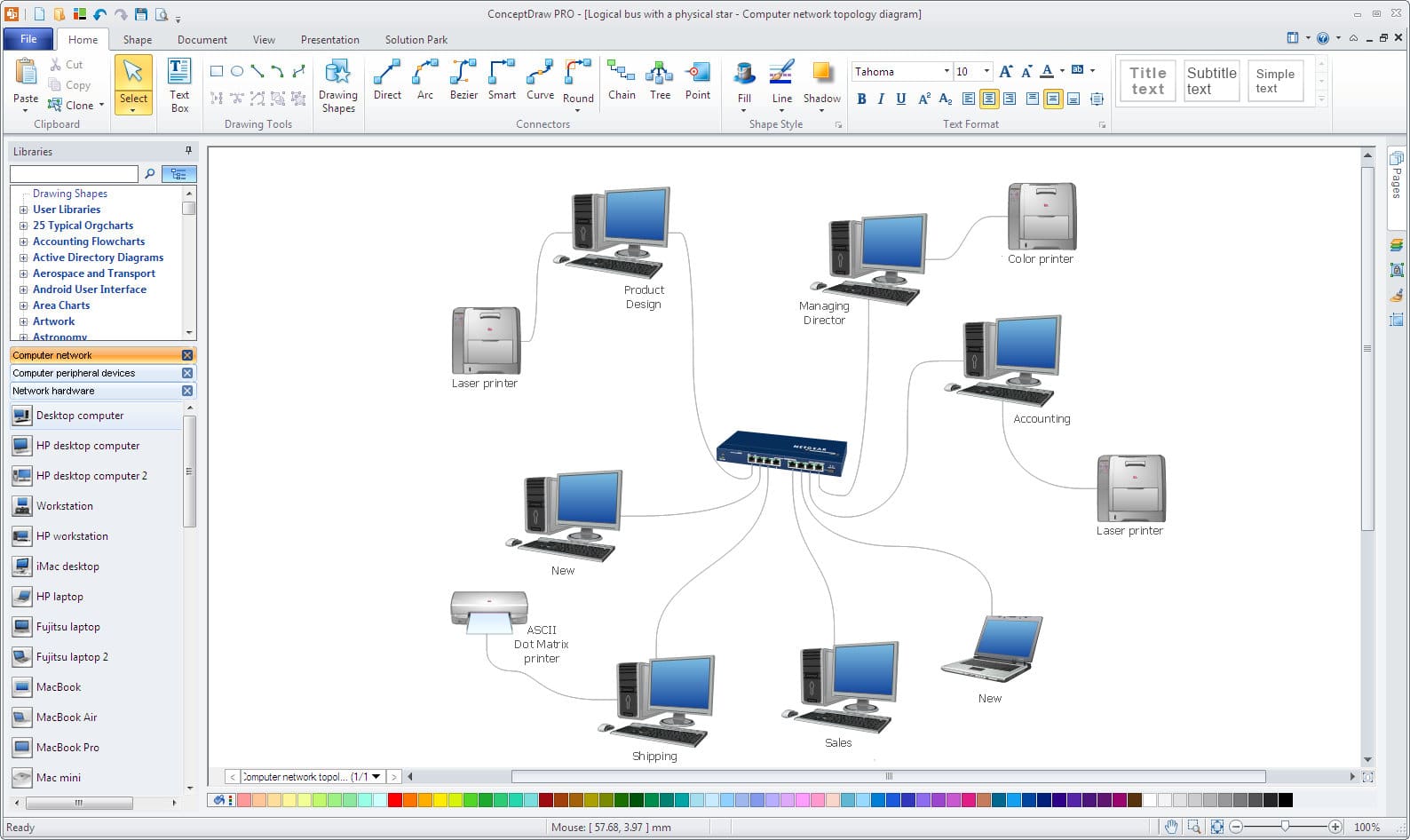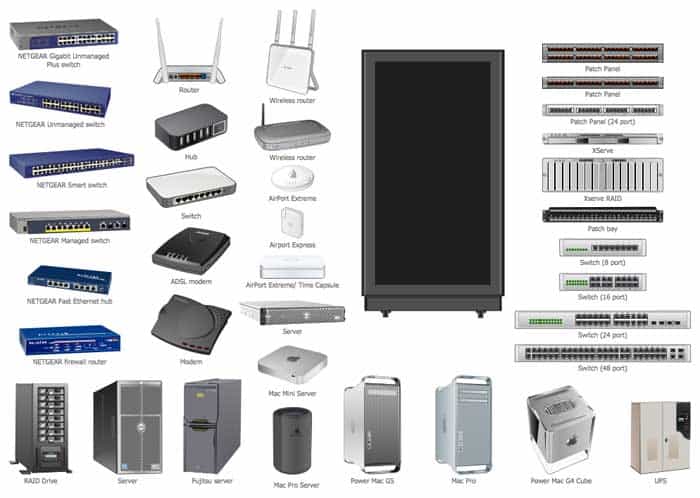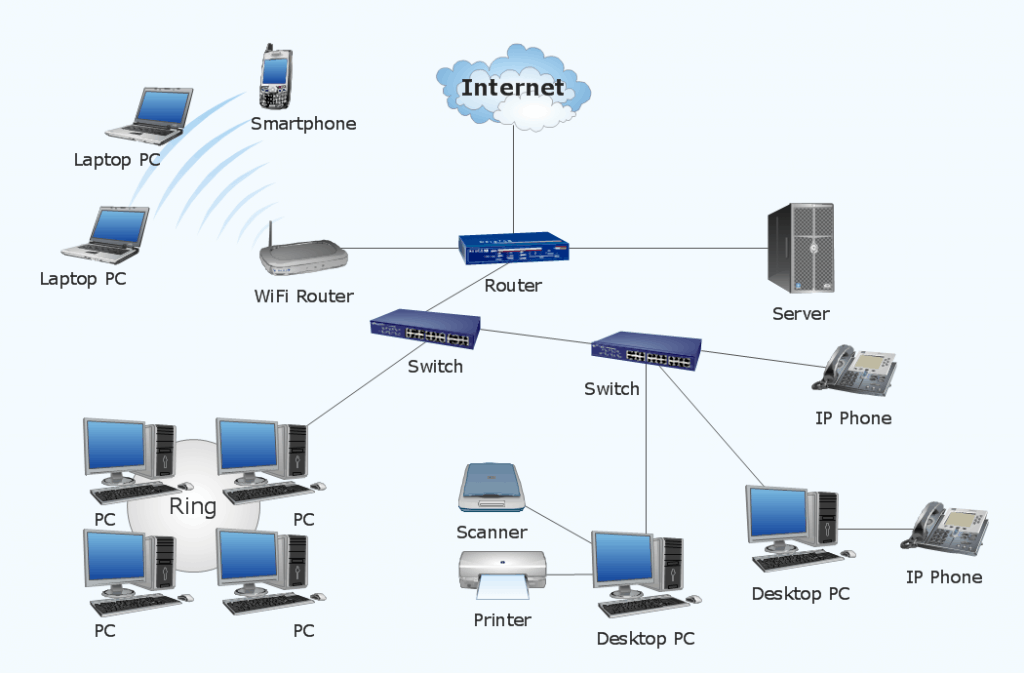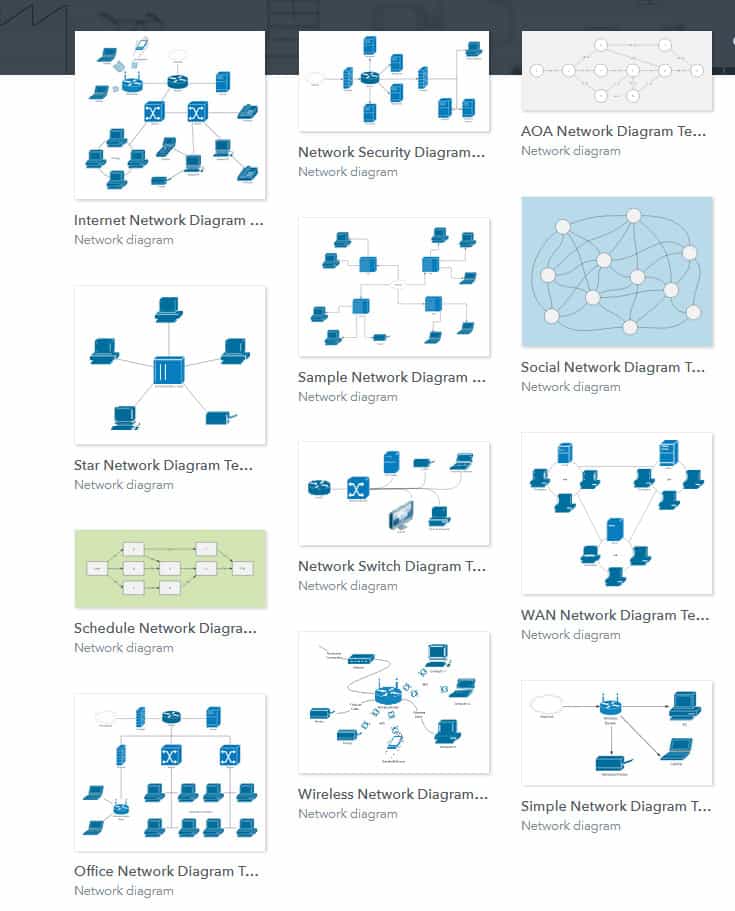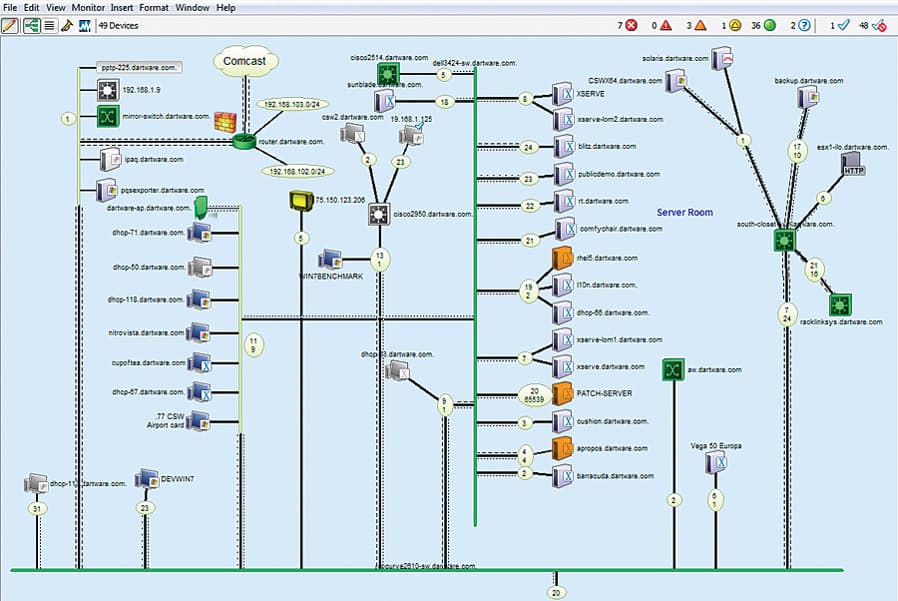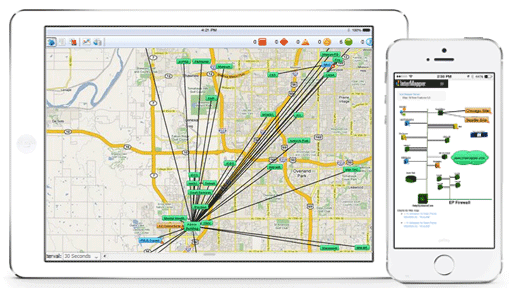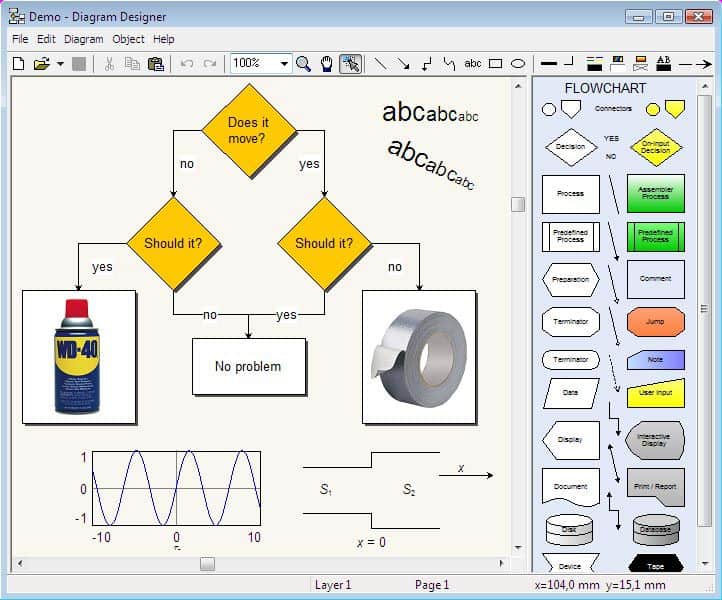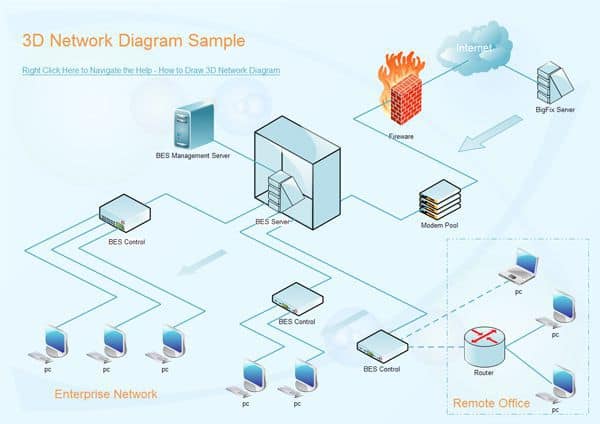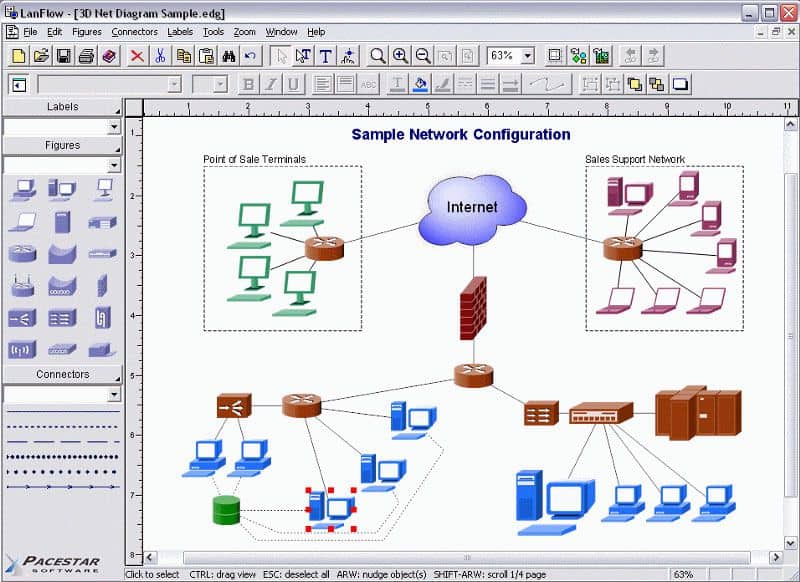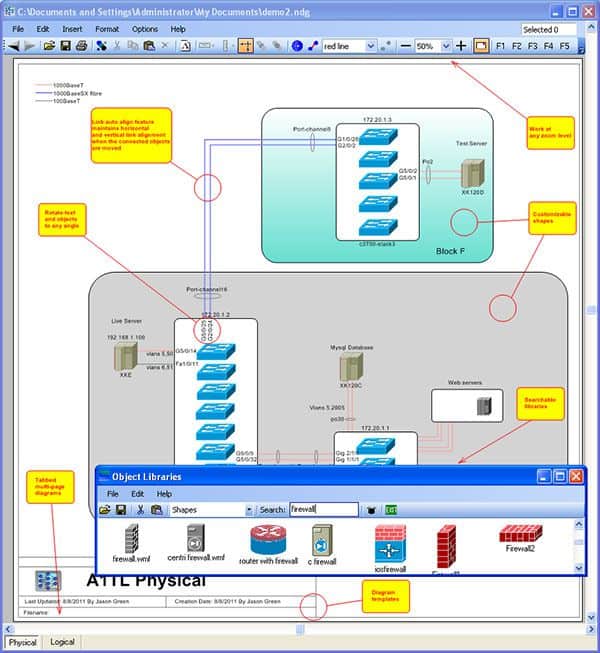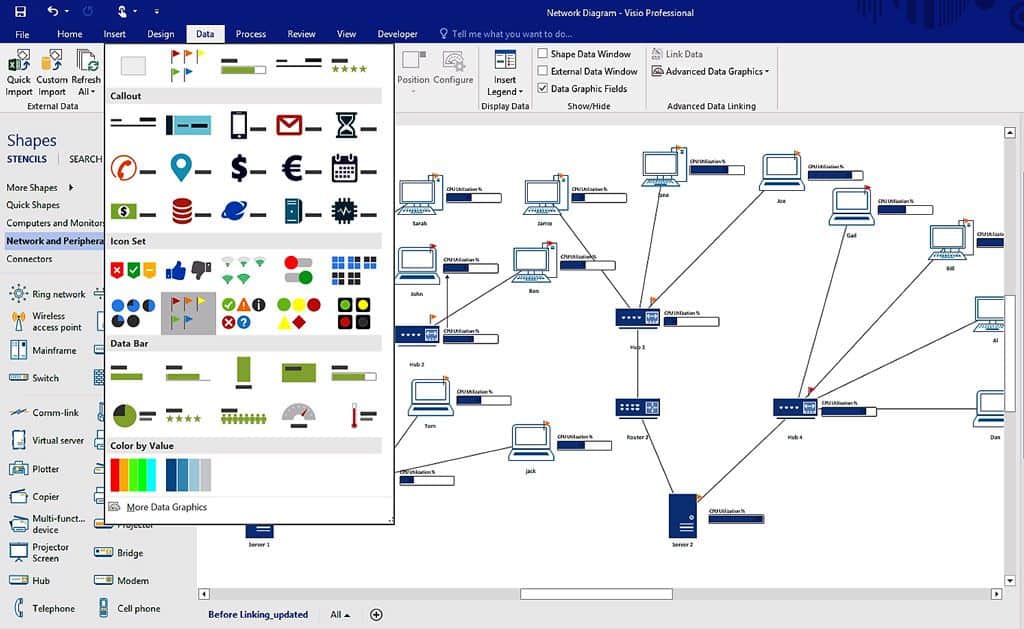We may earn a commission if you make a purchase through the links on our website.
The Top Network Diagram, Topology & Mapping Software

UPDATED: February 27, 2025
Network Diagrams are essential for ensuring your have a complete understanding of how your network topology is interconnected and can give you an overhead view of whats going on in your network.
Many times, it will help you visualize where your infrastructure is lacking and what needs to be upgraded/replaced.
Having a properly documented schematic of your entire network and connections can also ensure you can troubleshoot issues in a systematic order when they arise.
Here is our list of the top network diagram, drawing, topology, and mapping tools:
- Faddom – EDITOR'S CHOICE An on-premises package that discovers network devices and maps them, also creating an asset inventory. Runs as a virtual appliance. Register for a free trial.
- Datadog Network Performance Monitor – FREE TRIAL This network monitoring system also seeks out all attached devices and automatically draws up a topology map based on those findings. This is a cloud-based system. Get a 14-day free trial.
- ManageEngine OpManager – FREE TRIAL A package of network and server monitors that includes an automated network topology mapper. Available for Windows Server and Linux. Start a 30-day free trial.
- Site24x7 – FREE TRIAL Stands out in network diagram software, providing automated, real-time network diagramming ideal for modern IT infrastructures. Its capabilities in creating dynamic diagrams with customizable layouts and designs, integrated network performance monitoring, and easy sharing options make it a highly efficient tool for organizations that require accurate visualization of network topology and interconnections. Start a 30-day free trial.
- Domotz A cloud-based platform that offers network monitoring for LANs and WANs and is available in a multi-tenant architecture for managed service providers.
- ConceptDraw Diagram This design tool has libraries of icons that are specific to networking, such as typical depictions of switches, routers, servers, and desktops. The package can also be used to create other types of charts, diagrams, and presentations. Runs on Windows and macOS.
- Auvik This SaaS platform reaches out from the cloud to your network and searches for connected devices. It compiles a network inventory and then automatically draws up a network topology map. It scans all switch ports as well and details what devices are connected to each.
- SolarWinds Network Topology Mapper Push a button in this diagram designer and it will automatically scan your network and create a map for you. You then have the option to adjust the layout. Runs on Windows and Windows Server.
- Lucidchart This diagram design tool comes with a series of templates to depict different types of network diagrams, such as L2, L3, and security views. Available for Windows, macOs, Linux, and Chrome OS.
- Intermapper A network discovery and automated topology mapper that also supports network performance monitoring. Available for Windows, Windows Server, macOS, and Linux.
- Diagram Designer A nice, free diagramming tool that you can also get the source code for. Installs on Windows.
- EdrawMax A very sophisticated chart and diagram editor that produces great presentations. Runs on Windows, macOS, Linux, and Chrome OS.
- LanFlow A diagram editing tool with icons for network topology mapping. Installs on Windows.
- Network Notepad A network diagram designer with an autodiscovery add-on to automatically collect network topology data. Available in free and paid versions, this tool installs on Windows.
- Microsoft Visio Although it is expensive and doesn’t include a network discovery function, this design tool is the industry leader. Available for Windows and Windows Server.
The best Network Diagram Software, Topology Software & Mapping Tools
What should you look for in network topology mapping tools?
We reviewed the market for network diagram and mapping software and analyzed options based on the following criteria:
- An autodiscovery system that lists all devices on the network
- A switch port scanner that identifies how all devices connect together
- A recursive scan that constantly rechecks the network
- A network device inventory
- A dynamic mapping tool that creates a topology diagram from network inventory data
- A free trial or a demo service that enables you to test the software before buying it
- Value for money from an automated network discovery and documentation tool
With these selection criteria in mind, we identified a group of network diagramming and topology mapping systems that offer time-saving insights into the network layout.
Some of these software packages even automatically update your network topology map when new devices are added or removed from the network, which really cuts down on manually having to remove them yourself.
Below you will find an extensive list of the Top (some of which are FREE) Network Diagram Software packages available for download and trials.
A brief overview of the software is listed below to give you a better understanding of what it is capable of doing.
1. Faddom – FREE TRIAL
Faddom is agentless, self-service software that helps you visualize your on-premise and cloud infrastructure with continuous, automatic updates. It can be used to create network topology maps and application dependency maps.
Key Features
- Maps network and cloud infrastructure
- Application dependency mapping
- Interactive maps
Why do we recommend it?
Faddom is a network discovery and mapping system. The tool provides a network inventory as well and its detailed maps can be commanded at business-wide or business unit level. This tool can extend its maps out to cloud resources and so it includes internet connections in its displays.
The discovery process creates an asset inventory, listing details of each encountered device. That inventory forms the reference base for a topology mapper in the package. Each node on the map is clickable and leads through to the device details page.
The discovery process repeats automatically and so spots any changes made to the network. Those changes get reflected in the inventory, which automatically updates the network topology map. The service provides live statuses on device health and network traffic flows.
The software bundle for Faddom includes a custom VM, so it can run on any operating system as a virtual appliance.
Who is it recommended for?
Faddom prices its mapping system per server. However, it doesn’t publish the rate, so it is difficult to judge whether the tool would be suitable for cash-strapped startups and small businesses. Faddom recommends its cloud-based system for network managers and IT consultants. The company also offers change management and compliance tools.
Pros:
- Can be used for network mapping or for identifying application dependencies
- Provides a console for live network performance monitoring
- Includes network traffic flow monitoring
- Creates a hardware inventory, which is kept constantly up to date
- Creates a software inventory to aid patch management and license management
Cons:
- No SaaS package is available
There are two editions with scalable pricing according to the number of nodes that you want to monitor. For 100 instances, the Basic edition costs $120 per month and the Standard edition costs $240 per month. You can begin by registering for a free trial.
EDITOR'S CHOICE
Faddom is our top pick for a network diagram, topology, and mapping software system because it delivers unparalleled simplicity, accuracy, and speed in visualizing complex network infrastructures. Unlike traditional tools that require extensive manual input, Faddom’s autodiscovery feature automatically scans and maps your entire network in minutes, providing a real-time, up-to-date view of all devices, connections, and dependencies. This eliminates the need for time-consuming manual updates and ensures that your network maps are always accurate. Faddom’s intuitive interface and dynamic visualization capabilities make it easy to create detailed network diagrams and topology maps, whether you are managing a small business network or a large, multi-site enterprise. Its ability to map both on-premises and cloud environments, including AWS, Azure, and VMware, provides a holistic view of hybrid infrastructures, which is critical for modern IT teams. Faddom offers insights into application dependencies, helping teams understand how different components interact and ensuring smoother troubleshooting and planning. The cloud-based platform’s lightweight design and agentless architecture make it easy to deploy and scale without disrupting network operations. Whether you’re an IT professional, MSP, or enterprise, Faddom’s combination of automation, accuracy, and ease of use makes it the ultimate choice for network diagramming, topology mapping, and infrastructure visualization.
Download: Get a 14-day FREE Trial
Official Site: https://faddom.com/use-case/asset-documentation-and-discovery/
OS: Cloud based
2. Datadog Network Performance Monitor – FREE TRIAL
Datadog Network Performance Monitor is one of a list of infrastructure monitoring tools available from Datadog. The Datadog platform is a SaaS system, so you access the dashboard through any standard browser from anywhere. The system is able to monitor any network and can also extend its monitoring capabilities out over the internet to cloud resources.
Key Features
- SaaS package
- Automatic discovery
- Constantly updated topology maps
Why do we recommend it?
The Datadog Network Performance Monitor is a traffic analysis service. It is a companion to the Network Device Monitoring tool, which uses the Simple Network Management Protocol (SNMP) to track the statuses of switches and routers. The discovery service that underpins the network mapping feature requires a subscription to Datadog Infrastructure.
A key feature of the Network Performance Monitor is an automated device discovery system. This runs constantly, not just when you first create an account on the service. IT will spot any changes in your network and automatically update its network inventory. The service also draws up a series of network visualizations, based on the inventory. This is a live service, so any changes detected by the discovery module are instantly reflected in the network topology maps.
The network maps are interactive and you can query each node for statuses by hovering your pointer over it, or click through to a detailed status screen.
Datadog Network Performance Monitor is a subscription service, priced at a rate per host of $5 per month when paid annually or $7.20 month to month.
This service pairs well with other Datadog modules, such as the Network Device Monitor or the Infrastructure Monitor.
Who is it recommended for?
The Datadog platform is very popular and its pricing is scaleable so it will appeal to all sizes of businesses. Very small businesses with no spare budget for tools might proffer a free option, such as Network Notepad. Companies that subscribe to multiple Datadog modules will get the best use out of this platform.
Pros:
- Has one of the best interfaces for network mapping
- Uses live network mapping to pull in new devices, and reflects changes in the network right away
- Features data flow analysis to help administrators understand dependencies as well as performance metrics between devices
- The subscription model makes Datadog accessible to any size business
Cons:
- Would like to see a longer trial period
3. ManageEngine OpManager – FREE TRIAL
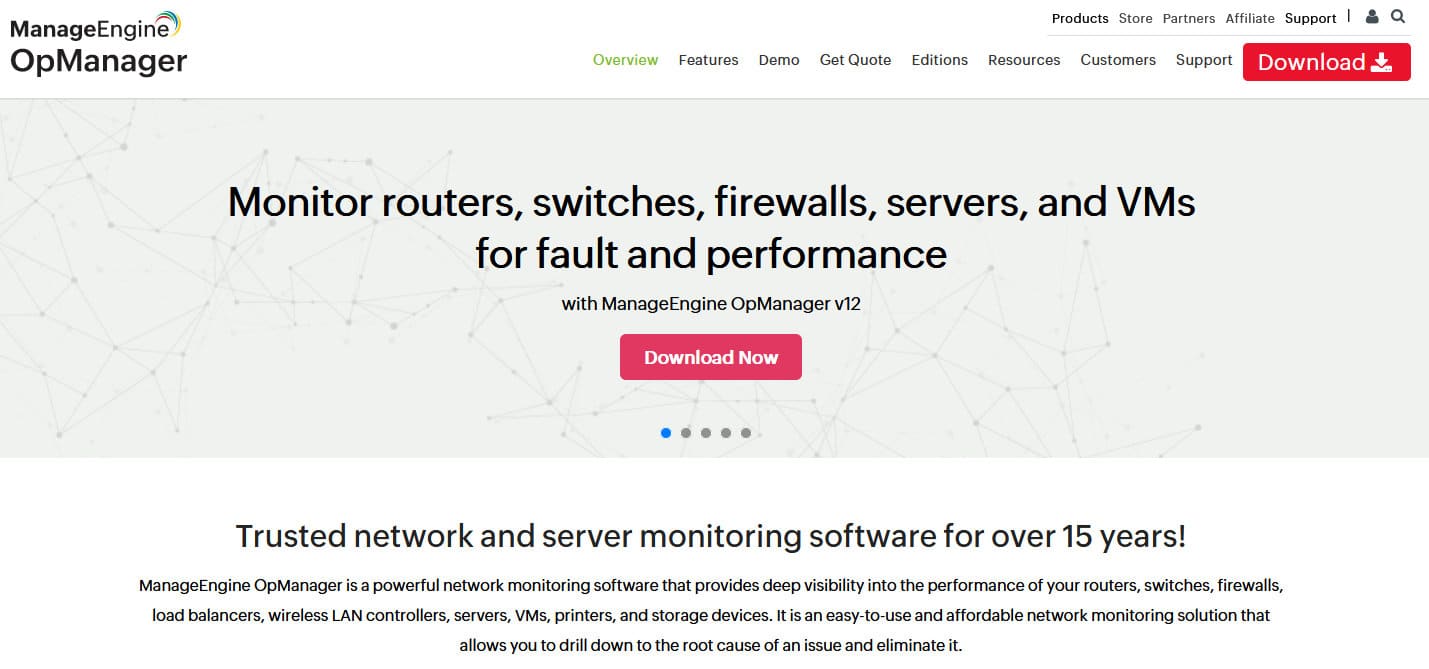
ManageEngine OpManager has an automatic network mapping utility built into its network monitoring capabilities. As well as monitoring networks, this system monitors servers and some applications and services. Among the services that this monitor will supervise are virtualizations and it maps the virtual infrastructure as well.
Key Features
- LAN diagrams
- WAN maps
- Server room and rack views
Why do we recommend it?
ManageEngine OpManager provides network and server monitoring through SNMP. This is an on-premises package for Windows and Linux and it includes a discovery service. The system creates a network inventory and a network topology map, providing a series of network representation options.
The mapper in OpManager creates network topology maps on demand. The information that these maps are based on comes from the network inventory. That inventory is constantly updated with periodic network scans. That means the topology map that you see is always based on the latest version of the network.
The topology mapper is able to present the network in a number of different formats. Here is an example of a layer 2 map, which only shows the switches on the network.
There are other layouts available. The service can plot a WAN on top of a real-world map. It can show a 3D image of the office building or a floor plan with the network and all connected equipment shown. It is also able to present a rack view.
ManageEngine OpManager is a software package that is available for Linux and Windows Server.
Who is it recommended for?
This system will appeal to any business that wants to host its own network monitoring software. There is a Free edition available, but that is limited to monitoring three devices. The Standard edition is accessibly priced for businesses with up to 25 devices on the network and the top edition, called Enterprise, serves multi-site businesses with 250 devices.
Pros:
- Supports network and server monitoring capabilities built into the topology map
- Has an option to simulate and track physical connections, great for messy switches and larger complex networks
- Uses both Ping and SNMP to discover devices, making it more thorough than some smaller tools
- Maps are automatically redrawn when a device changes, keeping it up to date and accurate every time it is viewed
- Available on both Linux and Windows
Cons:
- Is a feature-rich tool that requires time spent with the product to fully learn all of its features
OpManager offers four editions, each catering to different needs. The Free edition covers up to three devices at no cost, the Standard edition begins at $245 for monitoring 10 devices, the Professional edition starts at $345 for 10 devices, and the Enterprise edition for monitoring 250 devices starts at $11,545. Additionally, a 30-day free trial is available for download.
4. Site24x7 – FREE TRIAL
Site24x7 offers a compelling solution in the realm of network diagram software, essential for modern IT environments that require accurate and dynamic visualization of their network infrastructures. Site24x7 excels in providing automated and real-time network diagramming, coupled with customization options that cater to various requirements. This tool is highly suitable for organizations seeking an efficient way to create, manage, and maintain detailed network diagrams, ensuring a clear understanding of their network topology and interconnections.
Key Features
- Automated network discovery and mapping, creating dynamic network diagrams
- Real-time updates to network diagrams as changes occur in the network
- Customizable diagram layouts and designs to suit different requirements
- Integration with network performance monitoring for a comprehensive view of network health
- Easy sharing and exporting options for network diagrams, facilitating collaboration
Why do we recommend it?
Site24x7 is recommended for its ability to automate network diagram creation and maintain real-time accuracy. Its dynamic mapping and customizable features make it an invaluable tool for network administrators seeking to keep a clear and updated view of their network topology.
Who is it recommended for?
This tool is ideal for network administrators and IT professionals in medium to large organizations who require detailed and up-to-date network diagrams. It is particularly beneficial in complex network environments where understanding network topology is key to efficient management and troubleshooting.
Pros:
- Automated and dynamic network diagram creation
- Real-time updates reflecting network changes
- Customizable diagram layouts and easy-sharing options
Cons:
- May be more complex than required for smaller or simpler network setups
5. Domotz
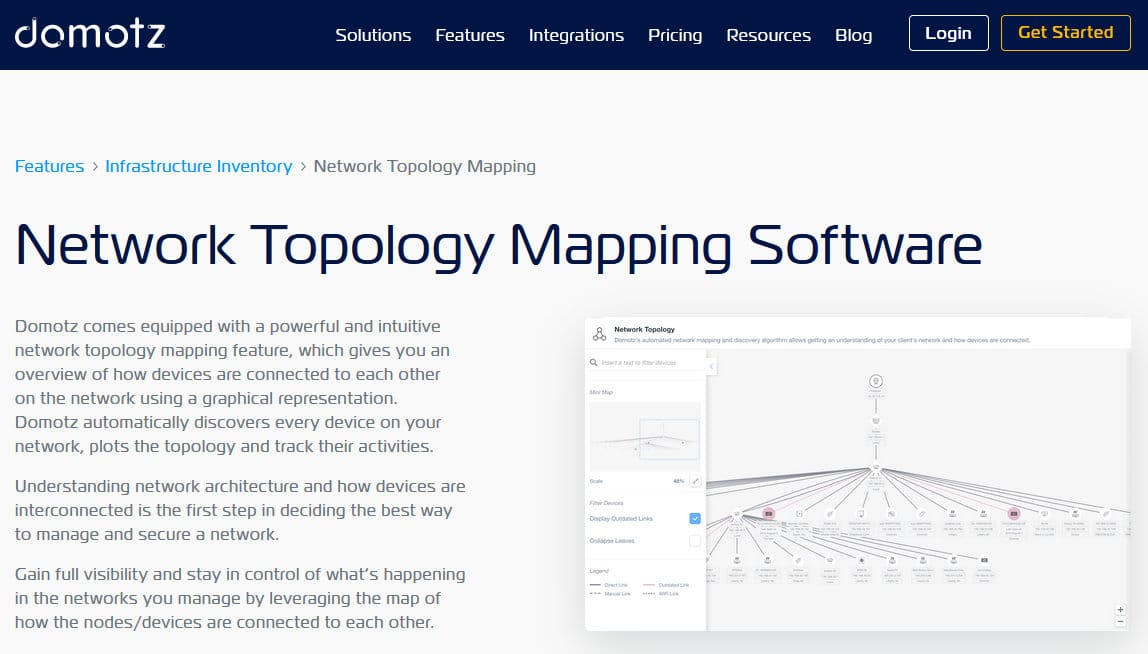
Domotz is a cloud-based service that offers network monitoring for LANs and can unify the monitoring of several sites. It also offers a multi-tenant architecture that makes it suitable for use by managed service providers (MSPs). The system constantly polls network devices and generates a network map from the information that it gleans.
Key Features
- SaaS package
- Automatic network scans
- Dynamic hierarchy-format mapping
Why do we recommend it?
Domotz reaches out from its cloud platform through a local agent to gather device data with a discovery routine. Its map is more of a connection hierarchy than a topology map. It shows the routes from a given device through to all the other devices on the network and looks more like a family tree.
The Domotz system installs an agent on the monitored network. This acts as a data gatherer and uploads that information to the Domotz server for processing. Domotz creates a network asset inventory from that data and then draws up the network map.
The information that helps compile the network map is also displayed as status reports. It is also stored for demand analysis and capacity planning.
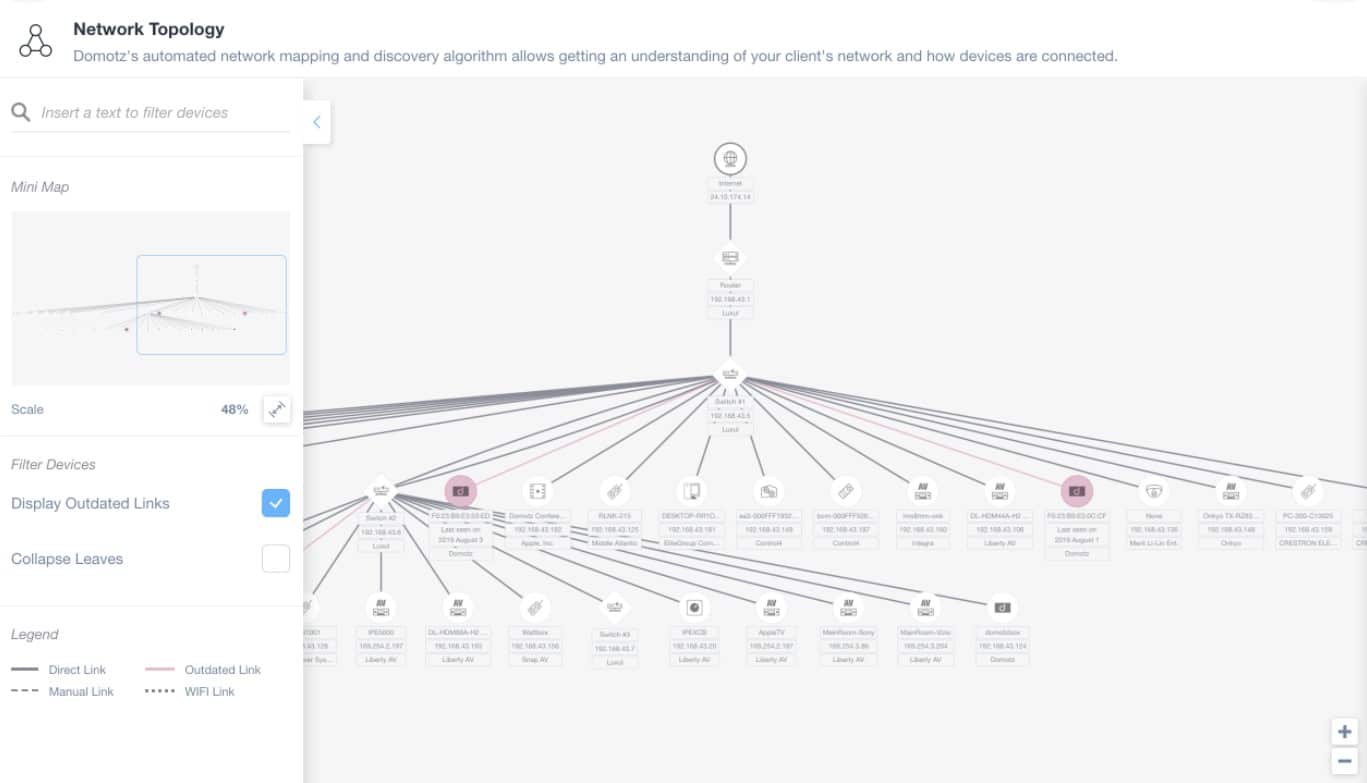
As a SaaS package, you access the Domotz system through any standard browser. The package will download an agent onto a server on your network and this process is managed by the Domotz interface.
Who is it recommended for?
This package is available in two editions and the first of these is priced per site, no matter how many devices are on the network. The rate for the service is affordable for small businesses but companies with large networks on each site will get the best value out of this cloud-based system.
Pros:
- Useful for centralizing the monitoring of multiple sites
- Suitable for managed service providers with a multi-tenant architecture
- Uses SNMP to poll network devices for status reports
- Creates a constantly updated network inventory and map
- Monitors physical, virtual, and wireless networks
Cons:
- No endpoint agent for macOS
Domotz is a subscription service and the standard plan is called Pro, with a rate of $21 per network per month. This is a flat rate and applies to networks of all sizes. An Enterprise plan is a custom package and is priced by negotiation.
6. ConceptDraw Diagram – best features overall
ConceptDraw Diagram is a business chart creator that is able to draw network maps, thanks to an icon library of network devices. The layout and menu bar of this tool is similar to the design of Microsoft Word.
ConceptDraw Pro is a very versatile Business diagramming and drawing tool that doubles as a network diagram tool as well.
Key Features
- High-end graphics editor
- Network icons
- Useful for other business charts
Why do we recommend it?
ConceptDraw Diagram is a graphics editor that can create a range of business charts, not just network maps. This is a software package for Windows and macOS. You don’t get a network discovery system to populate the map with the device currently on a network but you could use a tool such as SolarWinds Network Topology Mapper as a scanner and import network status from there.
The software’s interface is very familiar to that of Microsoft Word 2007 in terms of button layout and menus.
Because of its extensive menu and icon layout, it is Very Easy to use due to its Drag-n-Drop functionality, making this software easy to learn and use on a daily basis with very little training.
Sample of a Diagram Created in ConceptDraw Pro
You have the ability to create custom objects or shapes and saving them for future use within the Library.
Who is it recommended for?
This is an on-device tool and it can be used for any type of business chart. So, a small business or a consultancy that needs to create a lot of charts for different purposes would be drawn to this tool. Large companies that need to allow many employees have access to a charting tool would be better off with a cloud-based tool.
Pros:
- Lightweight tool that uses very little system resources
- Supports Visio file format
- Integrates well with other tools like Office and Google, making it a flexible option for users who use those tools
- Supported on Windows and Mac
Cons:
- No auto-discover functionality
- Does not support live devices in any way, and is strictly a charting software
- Graphics and interface feel outdated
The software is available for download and installation on Windows and macOS. Recommended RAM for both Operating systems is 1.5 GB and minimum 500 MB of space is needed to install. ConceptDraw Diagram is priced at $199.
7. Auvik
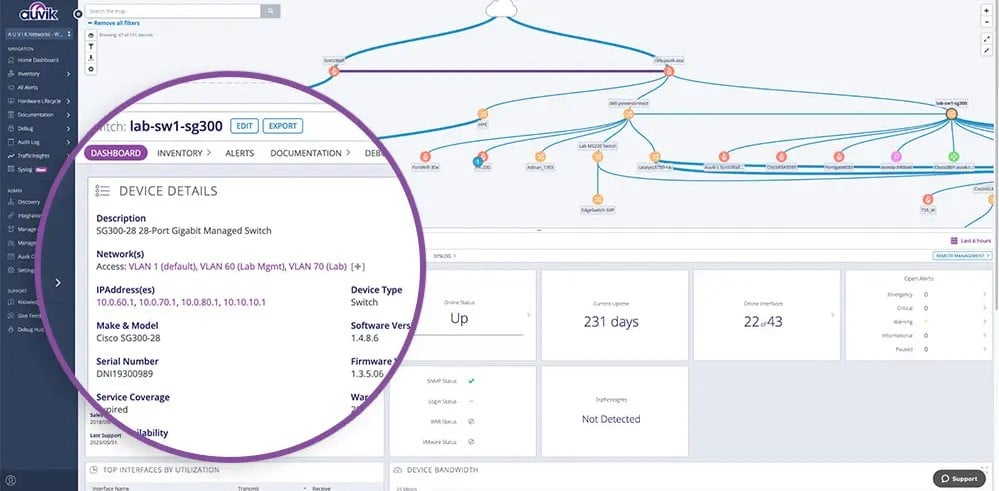
Auvik is a cloud service that offers network monitoring and management. At the heart of the Auvik system is a network discovery and topology mapping service. As it is hosted in the cloud, the Auvik system isn’t restricted to one site. It can map any network anywhere as long as you give it access.
Key Features
- Cloud-based
- Network discovery
- Topology mapping
- Network monitoring
- Network management tools
Why do we recommend it?
Auvik includes an autodiscovery routine that enables the package to assemble a network map. This SaSS package is delivered from the cloud and so able to map any network that you install its data collector on. The tool also assembles a network inventory, which provides details on each mapped device.
Another advantage of the cloud location of this software package is that it can be accessed from anywhere. This enables large businesses to centralize their network monitoring service and small businesses to let a single network technician track performance while away from his desk. The dashboard can be accessed from any device that has an internet connection.
The initial scan of the network creates a device inventory. This forms a menu for ongoing device monitoring and it is constantly updated.
The network topology map is drawn up automatically from the device information contained in the inventory. So, when a change occurs on the network, it is reflected in an updated inventory and a redrawn topology map.
The mapping services in the Auvik package can draw up plans at Layers, 1, 2, and 3, so you can flip between physical, switch-level, and router-level views of your system. Protocol analysis provides you with activity graphs that are segmented by application. See what are the major traffic generators and get an idea of where you can cap resource availability and share out the network more equitably. Identify interactive services and prioritize them with queueing to ensure a decent quality of service for VoIP and video streaming.
Auvik is a SaaS platform that is delivered from the cloud so its dashboard can be accessed from anywhere through any standard Web browser and it will document and map any network to which it is granted access.
Who is it recommended for?
This cloud-based system is available in two editions and both will map an unlimited number of networks, which means that the type of business that would get the best value for money from this package would be a multi-site organization or a managed service provider. Unfortunately, Auvik doesn’t publish its prices.
Pros:
- Remote access to networks from the cloud
- Autodiscovery of network devices
- Network topology mapping
- Continuously updated inventory and map
Cons:
- No software inventory features
Auvik is available in two editions, Essentials and Performance. The Performance plan has more features and so is more expensive. However, Auvik doesn’t publish its price list, so you have to contact the company and request a quote. Get a 14-day free trial.
8. SolarWinds Network Topology Mapper
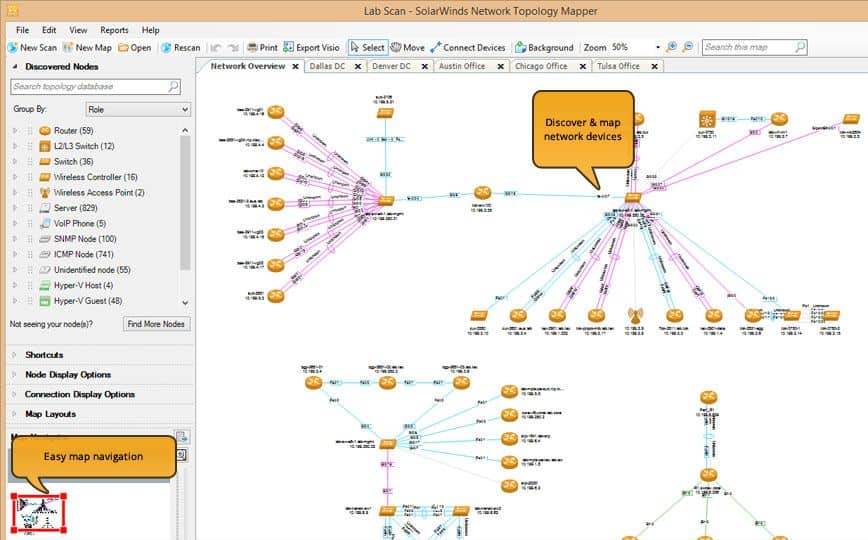
SolarWinds Network Topology Mapper (formerly known as LANSurveyor), is one of the Best, if not the best, diagramming tools on the market right now, especially for the Price you are paying compared to Microsoft Visio.
Key Features
- Runs on Windows Server
- Network scanner
- SNMP and Ping
- Attractive device icons
Why do we recommend it?
SolarWinds Network Topology Mapper is a standalone tool for Windows Server and it includes a network discovery routine that does all of the research work for you and then generates a network map. The tool can be used to scan a network for devices and then export the map to a graphics editor, such as Visio for adjustments.
Built-in network scanning Wizard and diagramming allows for jump-starting your drawings and automatic detection of new devices and changes on the network make this tool indispensable, especially with support for extensive discovery protocols and methods including SNMP, ICMP, WMI, CDP, VMware®, and Microsoft® Hyper-V®, along with many more.
This tool automatically builds network maps from single scans and populates them with industry-specific icons and clipart, along with providing reports for VLANs, subnet scanning, switch ports and more.
You can also exclude certain IP ranges and Subnets as needed through the Wizard. At this point, you can Group components by Roles, Vendor, Machine Type, Location, Subnet, VLAn or unidentified Nodes.
Added functionality, such as viewing only certain Layers are an added bonus for further detailed views.
You can then export your maps to PDF, PNG, Visio (.vdx file format), and even Orion® Network Atlas, along with exporting to SharePoint and other collaboration tools. PCI Compliance reports can also be exported out of this software quickly and effortlessly.
SolarWinds Network Topology Mapper takes care of all of the work for you. You don’t need to search through your network for details about your network devices and how they link together because the autodiscovery function in SolarWinds does that for you. You don’t even need to update your topology maps because SolarWinds periodically rescans your network, spots changes, and updates the map for you.
Who is it recommended for?
This package is a suitable choice for a large business that isn’t able to keep track of all its network devices. The autodiscovery routine saves a lot of time if you have just got rid of a network manager who didn’t document anything. The system provides a good baselining tool for businesses that want to redesign a network.
Pros:
- Uses auto-discover for automated mapping, great for larger more complex networks
- Uses multiple protocols to identify network devices, ICMP, SNMP, WMI, and CDP
- Designed to work in virtual environments and supports both VMWare and Hyper-V hosting
- Can build static maps and include devices from your network for capacity planning and testing
Cons:
- Would prefer a longer trial period
FREE Trial for 14 Days and $1495 thereafter.
9. Lucidchart
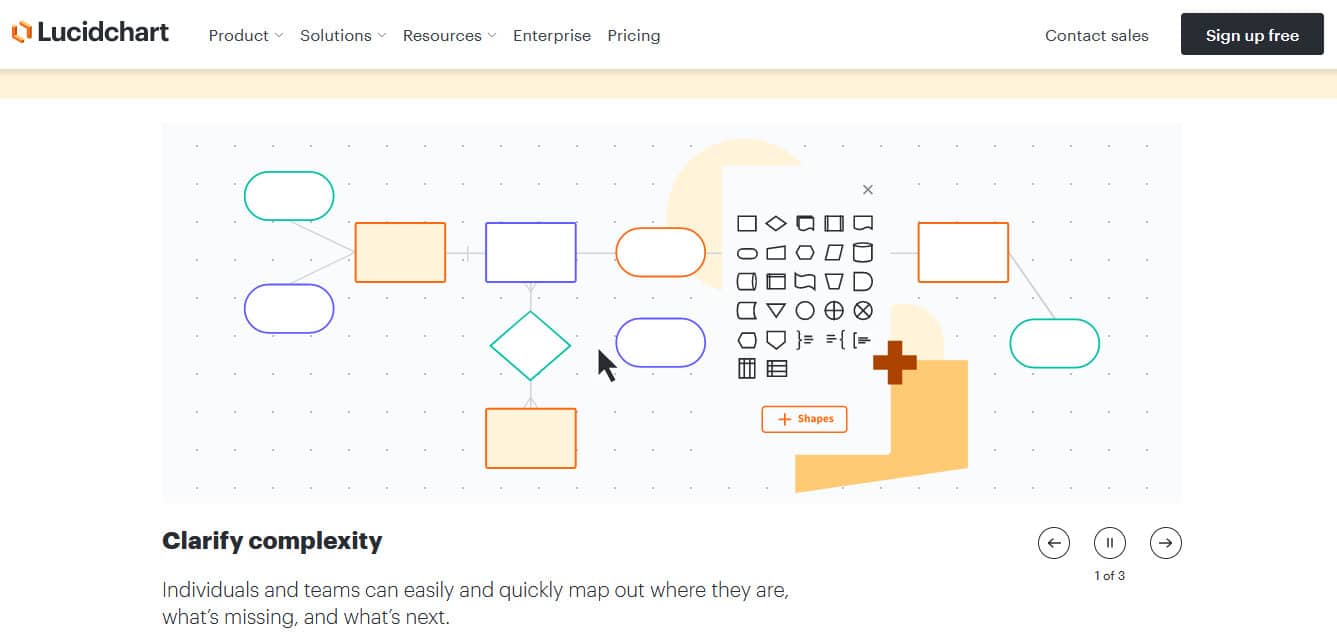
Lucidchart has a great offering and as of lately, probably one of the top solutions for those looking to create quick and easy topology diagrams of their network infrastructure.
They have a wide array of pre-built templates that are ready for you to plug in your data and quickly modify to your needs.
Key Features
- Template library
- Import and edit maps
- Desktop and mobile formats
Why do we recommend it?
Lucidchart is an online business chart creation package that has a library of network icons to create network topology maps. The system protects accounts with credentials and storage space for data and charts is protected by encryption. The system offers accounts for individuals and for teams.
Some examples of pre-built templates include the following in this image:
As you can see, you can grab an existing diagram and not have to waste time configuring and building one from scratch that will likely take twice as long to get to the same starting point as one of these.
Lucidchart has a great pricing program in place that allows for flexibility of use and allows you to quickly scale to more users if needed on the fly.
Who is it recommended for?
You can import existing maps that are created by network discovery in other applications if they are in Visio format. It is also possible to extract a network structure from AWS, GCP, and Azure and generate a map. There is a Free plan of the package that allows you to create three charts. Paid plans include at least 1 GB of storage.
Pros:
- Uses a simple color scheme and interface that makes maps look great
- Features a free and paid version
- Can import maps saved in Visio format, making this a good option if you plan to ditch Visio
- Team version allows for collaboration
- Is available multi-platform as well as on iOS and Android devices
Cons:
- No autodiscovery
- Does not support live devices in any way, is strictly a charting software
As of this writing, here is the pricing structure for Lucidchart for Network diagramming:
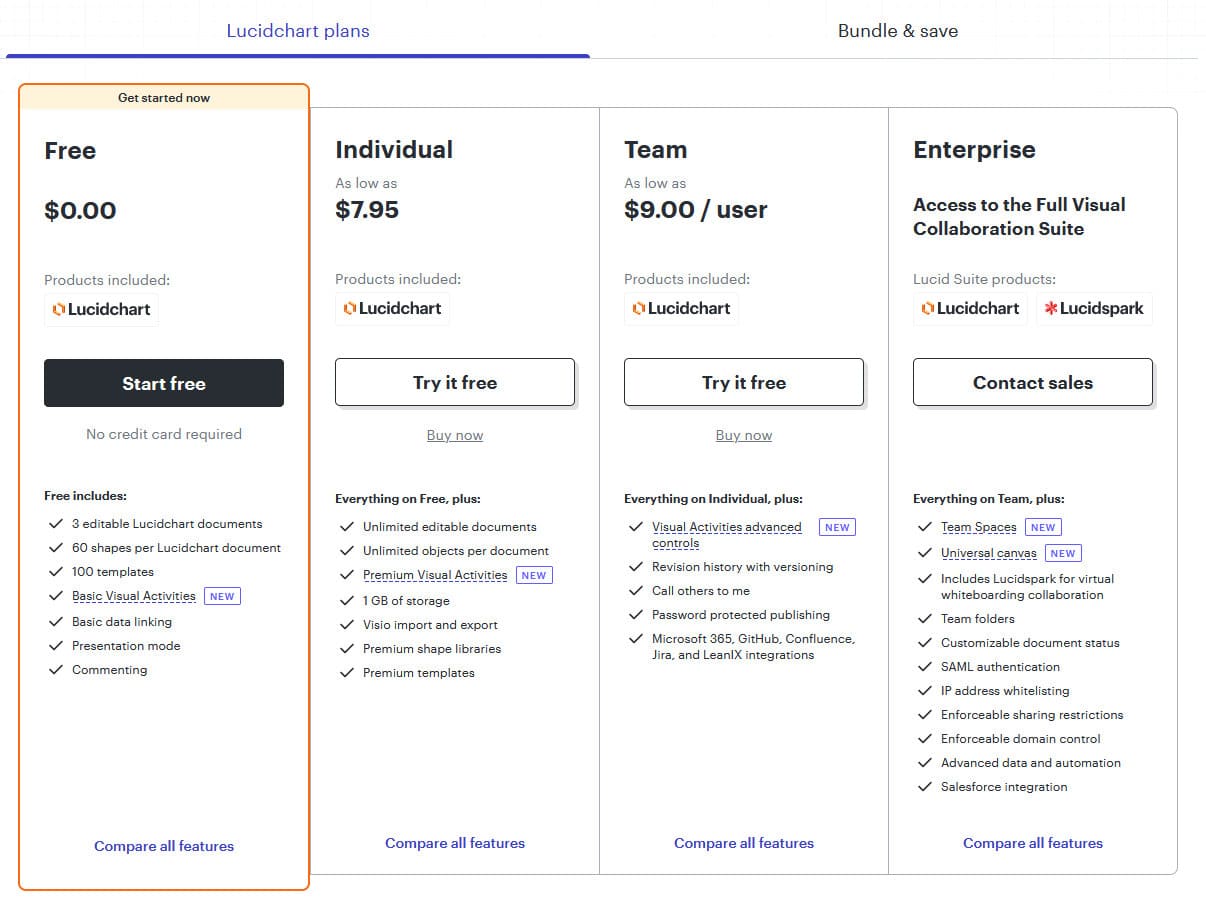
One of the most interesting and exciting features that stood out to us when looking at Lucidchart was the fact that you could import and export the Visio file format directly into Lucidchart and back out if needed.
This gives you the flexibility to share diagrams with people who are still using Visio for their diagramming needs.
Check out their Website for more information here and Pricing here. They even have a Free Trial version that you can test out and see if it suits your needs.
10. Fortra's Intermapper
Intermapper is network topology mapping and monitoring software for Windows, Linux, and Mac that provides a unique, sophisticated live view of network configuration and performance.
Key Features
- Network discovery and monitoring
- Live hierarchy maps
- Overlay on real-world maps
Why do we recommend it?
Fortra Intermapper has a network mapping service that can populate its records and generate a map through an autodiscovery process. The system is also able to show a WAN with all of its sites on a real-world map. This is a sophisticated tool that can export maps in Viso format.
Intermapper auto-discovers network devices and diagrams them on live network maps which users can personalize to reflect your unique IT infrastructure with hundreds of device icons, layout options, and background images.
Hierarchical mapping allows you to visualize the status of the whole network on a top-level map while drilling in to specific sub-maps by office location, floor, closet, etc.
Intermapper maps show a color-coded status of network equipment and animate live traffic flow to give you at-a-glance information on your network health that few products provide, in an easy-to-use, drag-and-drop interface.
Who is it recommended for?
Intermapper is an on-premises software tool and it is available for Windows, macOS, and Linux. The system will appeal to companies that need to make many changes to a network but it is really best suited for a networking consultancy that could get value for money by using the system for many clients.
Pros:
- Maps can be exported in Visio format
- Is capable of using auto-discovery to find new devices
- Features SLA compliance reporting, good for MSPs and larger networks
- Available on Window, Linux, and Mac, making it a flexible option across multiple operating systems
Cons:
- The interface feels outdated, making it difficult to navigate at times
- Visual options are limited
- Maps are generally not visually appealing, and not great if used in a presentation
11. Diagram Designer
Diagram Designer is another basic topology mapper. It is a vector graphics editor with a list of features that puts it ahead of its close rivals.
First off, Diagram Designer has a lot more selection of icons and symbols to choose from and has an easy interface to use as well.
Key Features
- Free to use
- Chart templates
- Exportable maps
Why do we recommend it?
Diagram Designer is a simple tool for planning small networks. You can import images for your own icons and also create icons in the editor and export them to other charting tools. The designer can be used to create entity relationship diagrams as well. This is a downloadable package for Windows.
More so, the program itself has a small footprint of only 2Mb, and supports Importing/Exporting WMF, EMF, BMP, JPEG, PNG, MNG, ICO, GIF and PCX file formats.
Who is it recommended for?
This is a good package for someone who is setting up a small business network. The network maps can be stored on your own hard drive and recalled for reference or to update the layout. This is a free tool and so it could also be a handy option for any network manager to keep on the computer just in case.
Pros:
- Highly customizable
- Supports numerous import/export file types such as WMF, EMF, BMP, JPEG, PNG, MNG, ICO, GIF and PCX images.
- Leverages file compression to support larger graphs
- Lightweight tool can run on legacy systems if needed
Cons:
- Visuals are very rudimentary and could use an update
- Is strictly for designing, and does not support live device mapping
- Larger companies will likely want more from a diagramming tool
Diagram Designer is Free.
12. EdrawMax
EdrawMax has the feel of Microsoft Visio and ConceptDraw Pro, with its elegant appearance and ease of use, it reminds us of using Microsoft Word, as the menu bar and ribbon is very similar to it.
This software package is more of an All-in-One business diagram software, which allows users to not only map out LAN’s and WAN’s, but produce compelling organizational and flow charts, business presentations, building plans, web design layouts and many more.
Key Features
- Free to use
- Chart templates
- Exportable maps
Why do we recommend it?
EdrawMax is a cloud-based system with a downloadable option. It can be used to create a range of business charts, including network maps. The strength of EdrawMax lies in its templates library, it has a very long list of layout options for network maps, including some for WANs.
EdrawMax is vector-based, which means you can Zoom in as close as you want without distorting any of the objects and elements on the page, and models can scale up if needed to print in large formats easily, and more importantly, print with clear, defined lines that are not distorted from resolution issues.
This software package also has the feature to import Visio xml files and change as needed, giving you up to 2000 types of clip art bundled into the installation.
Who is it recommended for?
You can import CAD and SVG files into the system but you don’t get a discovery routine with this package. The service has a free trial but it is for a limited period and all long term plans have to be paid for. The downloadable version is available for Windows, macOS, Linux, iOS, and Android.
Pros:
- Extremely detailed, can map out rack views, LDAP connections, and permission relationships
- Supports 2D and 3D views
- Available for Windows, Linux, and Mac
Cons:
- Dated and cluttered interface can feel overwhelming
- Lacks a live network component
- Cannot monitor devices on a network
- Lacks integrations found in similar tools
EdrawMax offers a free trial, and the full edition is available for $99.
13. LanFlow
Lanflow is a tool that is specifically meant for diagramming networks and computer-related schematics primarily, unlike some of the previous software we discussed, that are more well-rounded in terms of flexibility and functionality (business diagramming).
LanFlow has a drag-n-drop interface with allows you to place network equipment onto the canvas and then use “connectors” to interconnect them all.
Key Features
- Networking icons
- Drag-and-drop editor
- 3D option
Why do we recommend it?
LanFlow was made for network mapping and it doesn’t support other types of business charts. The package includes 2D and 3D icon libraries, which give you a choice over the appearance of your network design. The package is reasonably priced and is available for installation on Windows.
They give you the flexibility of defining borders and line weights as well. Some of the other features this software has to offer are hundreds of shares and symbols, in both black & white and 3D, Vector based designs, Snap Grid functionality for easy alignment of items, flow symbols and jogs (also known as a crossover) and much much more.
This software is fully featured and specifically designed for network mapping schematics.
Who is it recommended for?
This package is an on-device network map creator for Windows PCs. There isn’t a discovery routine in this tool, so you can’t get it to detect your network for you. So, this tool will be of interest to the owners of small networks that don’t take too much effort to plan out.
Pros:
- Uses a simple, but effective interface that is easy to use even for non-technical users
- Supports 2D and 3D modeling, good for presentations
- Can build your own icons, making it highly customizable
Cons:
- Only available for Windows
- Does not support auto-discovery
- Does not support live device management
LanFlow is priced at $99 for a single license, with discounts offered for purchases of multiple licenses.
14. Network Notepad
Network Notepad (FREE) is just as the name of the software implies, a program for creating interactive diagrams of networks and their components.
This tool has a great add-on worth mentioning called “CDP Neighbor Tool” (Cisco Discovery Protocol), which is a function that will pull information from the CDP table of a selected Cisco device that has CDP enabled and draw and map out the network components based on that table.
Key Features
- Graphics editor
- Networking icons
- Multi-user collaboration
Why do we recommend it?
This is a lightweight system in free and paid versions. None of the versions has an autodiscovery function but you can get a free add-on that implements the Cisco Discovery Protocol (CDP) that works with all editions. One problem is that only Cisco uses this discovery protocol but there is a compatible protocol called the Industry Standard Discovery Protocol (ISDP) that Dell and Netgear use.
Fully scalable using vector-based graphics, zooming in and working on a granular level is a pleasure with no pixelated resolution and can create “Custom Shapes” for your devices within the software.
The interface of the software feels like Microsoft Word 2003 interface, with no ribbon menu as some of the other software we have reviewed.
Who is it recommended for?
There are three editions of Network Notepad: Free, Professional, and Enterprise. None of the versions include an autodiscovery service, and the discovery add-on isn’t guaranteed to work with all brands of network devices. So, you would use this tool to design or document a small network.
Pros:
- Supports two versions, one for network mapping and another for simple charting
- Barebones interface makes this a lightweight and clutter-free tool
- Supports in-depth networking details like VLANs, subnets, and address pool
Cons:
- Only available for Windows
- Only uses ping to discover devices
The FREE edition of the software is compatible with Microsoft Windows 9x, NT, 2K, XP, and Vista, but does not specifically mention support for Windows 7, 8.1, or 10. However, the Professional version is compatible with all newer Microsoft versions, including Windows 10, 8, 7, Vista, XP, and 2000, which is an important consideration for downloading. The software is available in a Free version, and the Professional Version is priced at £16 GBP per license.
15. Microsoft Visio
Microsoft Visio is probably the most well-known network mapping and layout software among Business & IT professionals alike.
The package is available for subscription with two plans that are priced at $5 per month and $15 per month when paid annually. A perpetual license costs $369.99 for Visio Standard 2021 or $719.99 for Visio Professional 2021. Many of the software packages we reviewed above have built their interfaces around Microsoft's popular Ribbon and Menu systems.
Key Features
- Graphics editor industry leader
- Network icons
- Topology templates
Why do we recommend it?
Microsoft Visio is the leader of the pack in charting software. However, it is also the most expansive. You don’t get a discovery service with this tool but its proprietary file format is the industry standard and you can find many network discovery systems that will discover a network and draw up a map that you can import into Visio to make adjustments.
The newer versions of Visio now have added functionality that allows people to comment on your Diagrams through either Visio itself or through a Browser (using Sharepoint) and even goes as far as built-in Instant messaging using either Microsoft Skype for Business or Lync.
Bundled into the software are over 70 pre-built templates and thousands of Shapes, including IT focused elements that represent Active Directory components, as well as detailed network components and Network appliances and routes.
Visio also has shapes and components for Datacenter, help desk, HVAC layouts, Enterprise and Home network diagramming and many more options.
It's truly a fully featured diagramming tool for not only business professionals, but for IT professionals who need serious diagramming capabilities.
One downside to Visio is the inability to scan Networks and automatically populate your diagram for you natively, although you can do this with an add-on for Microsoft Baseline Security Analyzer called Visio Connector, which can be used to scan your network and view the results in a fairly thorough Visio diagram.
Who is it recommended for?
This is a high-end tool and will appeal to large businesses. The subscription plan removes the high upfront cost of using the system and can make the tool more accessible to smaller businesses. However, companies on tight budgets could save money by using one of the other tools on this list that can import and export Visio files.
Pros:
- Easy to use, part of the Microsoft Suite
- Good for network planning and theoretical designs
- Widely used file format
Cons:
- Only available in Windows
- Lacks live network auto-discovery builtin (The plug-in is no longer supported)
- Fairly expensive when compared to its competitors
Visio offers several pricing options, including Visio Standard 2021 for $369.99 and Visio Professional 2021 for $719.99. There are also subscription plans available at $5 or $15 per month.
